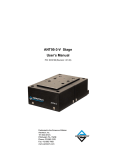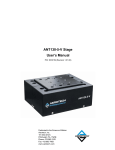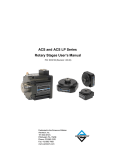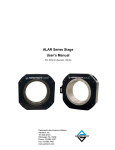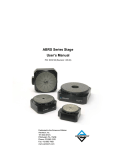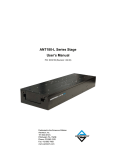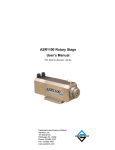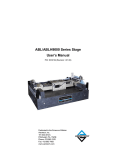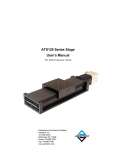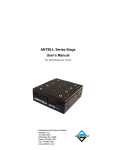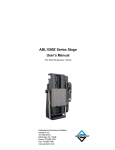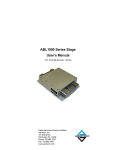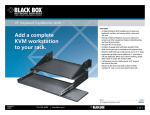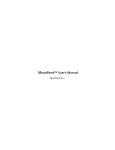Download ADRT Series Stage User`s Manual
Transcript
ADRT Series Stage User’s Manual P/N: EDS136 (Revision 1.01.00) Dedicated to the Science of Motion Aerotech, Inc. 101 Zeta Drive, Pittsburgh, PA, 15238 Phone: 412-963-7470 Fax: 412-963-7459 www.aerotech.com Product Registration Register online at: http://www.aerotech.com/prodreg.cfm Technical Support United States Headquarters: Phone: (412) 967-6440 Fax: (412) 967-6870 Email: [email protected] United Kingdom: Phone: +44 118 940 9400 Fax: +44 118 940 9401 Email: [email protected] Germany: Phone: +49 911 967 9370 Fax: +49 911 967 93720 Email: [email protected] Japan: Phone: +81(0)47-489-1741 (Sales) Phone: +81(0)47-489-1742 (Service) Fax: +81(0)47-489-1743 Email: [email protected] China: Phone: +852-3793-3488 Email: [email protected] Revision History Revision 1.01.00 March 11, 2011 Revision 1.00.00 January 15, 2009 Product names mentioned herein are used for identification purposes only and may be trademarks of their respective companies. © Aerotech, Inc. 2011 ADRT Series Stage User's Manual Table of Contents Table of Contents Table of Contents List of Figures List of Tables iii v vii Chapter 1: Overview 1 1.1. Standard Features 1.1.1. Optional Features 1.1.2. Model Numbers 1.2. Dimensions 1.3. Safety Procedures and Warnings 1.4. EC Declaration of Incorporation Chapter 2: Installation 2.1. Unpacking and Handling the Stage 2.2. Preparing the Mounting Surface 2.3. Securing the Stage to the Mounting Surface 2.4. Attaching the Payload to the Stage 2.5. Electrical Installation Chapter 3: Operating Specifications 3.1. Environmental Specifications 3.2. Accuracy and Temperature Effects 3.3. Basic Specifications 3.4. Load Capability 3.5. Limit Switch Wiring 3.5.1. Limit Switch Operation (Option) 3.5.2. Optical Limit Adjustment 3.6. Standard Motor Wiring 3.7. Vacuum Operation Chapter 4: Maintenance 4.1. Service and Inspection Schedule 4.1.1. Field Service 4.2. Cleaning and Lubrication 4.2.1. Recommended Cleaning Solvents 1 1 2 4 11 13 15 15 16 17 19 19 21 21 21 22 24 29 29 31 33 34 35 35 35 35 35 Appendix A: Warranty and Field Service 37 Appendix B: Technical Changes 39 Index 41 Reader's Comments 43 www.aerotech.com iii Table of Contents iv ADRT Series Stage User's Manual www.aerotech.com ADRT Series Stage User's Manual List Of Figures List of Figures Figure 1-1: Figure 1-2: Figure 1-3: Figure 1-4: Figure 1-5: Figure 1-6: Figure 1-7: Figure 2-1: Figure 2-2: Figure 2-3: Figure 2-4: Figure 3-1: Figure 3-2: Figure 3-3: Figure 3-4: Figure 3-5: Figure 3-6: Figure 3-7: Figure 3-8: Figure 3-9: Figure 3-10: Figure 3-11: Figure 3-12: Figure 3-13: ADRT-100 Dimensions ADRT-150 Dimensions ADRT-150-LI-HS Dimensions ADRT-200 Dimensions ADRT-200-LI-HS Dimensions ADRT-260 Dimensions ADRT-260-LI-HS Dimensions Results of Flat Versus Non-Flat Mounting Top View of an ADRT-260 Stage Showing Mounting Holes Side View of an ADRT-260 Stage Showing Tapped Mounting Holes and T-Slot Grooves ADRT Stage Components Load Orientations ADRT-100-85 Cantilevered Load Capability ADRT-100-135 Cantilevered Load Capability ADRT-150-115 Cantilevered Load Capability ADRT-150-135 Cantilevered Load Capability ADRT-150-180 Cantilevered Load Capability ADRT-200-155 Cantilevered Load Capability ADRT-200-185 Cantilevered Load Capability ADRT-260-160 Cantilevered Load Capability ADRT-260-180 Cantilevered Load Capability Limit Switch Wiring Bottom View of the ADRT ADRT Limit Flag Adjustment www.aerotech.com 4 5 6 7 8 9 10 16 17 18 19 24 24 25 25 26 26 27 27 28 28 29 31 32 v List of Figures vi ADRT Series Stage User's Manual www.aerotech.com ADRT Series Stage User's Manual List of Tables List of Tables Table 1-1: Table 3-1: Table 3-2: Table 3-3: Table 3-4: Table 3-5: Table B-1: Table B-2: Model Numbering System Environmental Specifications ADRT Series Specifications End of Travel Limit Configurations Standard Wiring Connectors for ADRT Stages Motor Wiring Pinout Descriptions Current Changes (1.01.00) Archived Changes www.aerotech.com 2 21 22 30 33 34 39 40 vii List of Tables viii ADRT Series Stage User's Manual www.aerotech.com ADRT Series Stage User's Manual Overview Chapter 1: Overview This chapter introduces standard and optional features of the ADRT stages, explains the model numbering system, and gives general safety precautions. 1.1. Standard Features All ADRT stages include a direct drive brushless motor. The low inherent inertia and this optimized motor design give the ADRT the capability of speeds and accelerations that are significantly higher than other competing products. The ADRT is designed to provide superior angular positioning and velocity control, as well as permit large payloads without compromising performance. The design also maximizes performance with respect to wobble, moment stiffness, and repeatability. Applications for the ADRT range from indexing to high-speed laser machining to precision wafer inspection. Low inertia and zero backlash make the ADRT the ideal solution for applications requiring frequent directional changes. 1.1.1. Optional Features All ADRT stages incorporate a center aperture, ranging in size from 13 mm to 100 mm. The stages also have options for high-precision bearing and a brake. Multiple limit options are also available. The mounting holes are designed for metric screws on a metric pattern. The hole patterns are 80 mm SQ, 125 mm SQ, and 170mm SQ, and 230 mm, respectively, for the ADRT-100, ADRT-150, ADRT-200, and ADRT-260. Multiple motor size options are available, depending on torque requirements and the encoder can be configured for either square-wave or amplified sine output. www.aerotech.com Chapter 1 1 Overview ADRT Series Stage User's Manual 1.1.2. Model Numbers The stage model number indicates the optional features on a particular stage. To determine the options on your stage, refer to Table 1-1 for an explanation of the numbering system. Example: ADRT150-115-S-50mm-AS-NO-UNLIMITED-PLOTS This designates an ADRT-150 direct-drive rotary table with 50 mm clear aperture, 2.36 N-m continuous torque, standard grade bearings, standard feedback device, no brake, continuous rotation, and standard accuracy and repeatability documentation. Aerotech continually improves its product offerings, and listed options may be superseded at any time. Refer to the most recent edition of the Aerotech Motion Control Product Guide for the most current product information at www.aerotech.com. Table 1-1: Model Numbering System ADRT Series Rotary Stage ADRT-100-85 Direct-drive rotary table with 13 mm clear aperture and 0.53 N-m continuous torque ADRT-100-135 Direct-drive rotary table with 13 mm clear aperture and 1.6 N-m continuous torque ADRT-150-115 Direct-drive rotary table with 50 mm clear aperture and 2.36 N-m continuous torque ADRT-150-135 Direct-drive rotary table with 50 mm clear aperture and 4.18 N-m continuous torque ADRT-150-180 Direct-drive rotary table with 50 mm clear aperture and 7.69 N-m continuous torque ADRT-200-155 Direct-drive rotary table with 75 mm clear aperture and 11.12 N-m continuous torque ADRT-200-185 Direct-drive rotary table with 75 mm clear aperture and 15.93 N-m continuous torque ADRT-260-160 Direct-drive rotary table with 100 mm clear aperture and 19.71 N-m continuous torque ADRT-260-180 Direct-drive rotary table with 100 mm clear aperture and 29.09 N-m continuous torque Stage Bearing Options -S Dual standard-grade bearings -P Dual precision-grade bearings Shaft Configuration(1) -50mm 50mm clear aperture -35mm 35mm clear aperture (1) Required for ADRT-150-xxx only 2 Chapter 1 www.aerotech.com ADRT Series Stage User's Manual Overview Table 1-1: Model Numbering System (continued) Position Transducer -AS Standard feedback device; 1 Vpp sine wave output; 240 arc*sec resolution on ADRT-200/260 and 360 arc*sec resolution on ADRT-150; final resolution multiplier dependent -X5 Square wave digital output; 12 arc*sec resolution on ADRT-200/260 and 18 arc*sec on ADRT-100/150 -X10 Square wave digital output; 6 arc*sec resolution on ADRT-200/260 and 9 arc*sec resolution on ADRT-100/150 -X25 Square wave digital output; 2.4 arc*sec resolution on ADRT-200/260 and 3.6 arc*sec resolution on ADRT-100/150 -X50 Square wave digital output; 1.2 arc*sec resolution on ADRT-200/260 and 1.8 arc*sec resolution on ADRT-100/150 Note: Digital output encoder signals are synthesized with a 16 MHz clock. Care must be taken to ensure that the encoder sample rate on the controller is at least 16 MHz or higher. Slower clock rate are available on request. Break Options(2) -NO No brake -BK Holding brake (2) Not available on ADRT-100 Limits -UNLIMITED Continuous Rotation -LI±x Normally-closed limits at ±x degrees, where x=5/10/20/30/40/45/50/60/70/80/90/100/110/120/130 -HS±x Hardstop end of travel at ±x degrees, where x=10/15/25/35/45/50/55/65/75/85/95/105/115/125/135 -SRCE Current sourcing limits -HCW Home limit uses clockwise limit (counter clockwise default) -NOP Normally open limit (normally closed default) -24V 24 VDC rated limits Options -PLOTS Stage accuracy and repeatability documentation; included with –P; optional with –S -HPD 4-pin D-style motor power connector with 25-pin D-style feedback connector. Stage-mounted connectors on ADRT-150-xxx, ADRT-200-xxx, and ADRT-260-xxx. Strain-relieved 300 mm pigtail cable connection on ADRT-100-xxx. -D25 25-pin D-style motor power connector with 25-pin D-style feedback connector. Stage-mounted connectors on ADRT-150-xxx, ADRT-200-xxx, and ADRT-260-xxx. Strain-relieved 300 mm pigtail cable connection on ADRT-100-xxx. -S Rear shaft seal on ADRT-100-xxx -P Air-purge fitting www.aerotech.com Chapter 1 3 Overview ADRT Series Stage User's Manual 1.2. Dimensions Figure 1-1: 4 ADRT-100 Dimensions Chapter 1 www.aerotech.com ADRT Series Stage User's Manual Figure 1-2: www.aerotech.com Overview ADRT-150 Dimensions Chapter 1 5 Overview ADRT Series Stage User's Manual Figure 1-3: 6 ADRT-150-LI-HS Dimensions Chapter 1 www.aerotech.com ADRT Series Stage User's Manual Figure 1-4: www.aerotech.com Overview ADRT-200 Dimensions Chapter 1 7 Overview ADRT Series Stage User's Manual Figure 1-5: 8 ADRT-200-LI-HS Dimensions Chapter 1 www.aerotech.com ADRT Series Stage User's Manual Figure 1-6: www.aerotech.com Overview ADRT-260 Dimensions Chapter 1 9 Overview ADRT Series Stage User's Manual Figure 1-7: 10 ADRT-260-LI-HS Dimensions Chapter 1 www.aerotech.com ADRT Series Stage User's Manual Overview 1.3. Safety Procedures and Warnings The following statements apply throughout this manual. Failure to observe these precautions could result in serious injury to those performing the procedures and damage to the equipment. This manual and any additional instructions included with the stage should be retained for the lifetime of the stage. To minimize the possibility of electrical shock and bodily injury or death, disconnect all electrical power prior to making any electrical connections. To minimize the possibility of electrical shock and bodily injury or death when any electrical circuit is in use, ensure that no person comes in contact with the circuitry when the stage is connected to a power source. To minimize the possibility of bodily injury or death, disconnect all electrical power prior to making any mechanical adjustments. Moving parts of the stage can cause crushing or shearing injuries. All personnel must remain clear of any moving parts. Improper use of the stage can cause damage, shock, injury, or death. Read and understand this manual before operating the stage. If the stage is used in a manner not specified by the manufacturer, the protection provided by the stage can be impaired. Stage cables can pose a tripping hazard. Securely mount and position all stage cables to avoid potential hazards. www.aerotech.com Chapter 1 11 Overview ADRT Series Stage User's Manual Do not expose the stage to environments or conditions outside the specified range of operating environments. Operation in conditions other than those specified can cause damage to the equipment. The stage must be mounted securely. Improper mounting can result in injury and damage to the equipment. Use care when moving the stage. Manually lifting or transporting stages can result in injury. Only trained personnel should operate, inspect, and maintain the stage. This stage is intended for light industrial manufacturing or laboratory use. Use of the stage for unintended applications can result in injury and damage to the equipment. Before using this stage, perform an operator risk assessment to determine the needed safety requirements. 12 Chapter 1 www.aerotech.com ADRT Series Stage User's Manual Overview 1.4. EC Declaration of Incorporation Manufactorer: Aerotech, Inc. 101 Zeta Drive Pittsburgh, PA 15238 USA herewith declares that the product: Aerotech, Inc. ADRT Stage is intended to be incorporated into machinery to constitute machinery covered by the Directive 2006/42/EC as amended; does therefore not in every respect comply with the provisions of this directive; and that the following harmonized European standards have been applied: EN ISO 12100-1,-2:2003+A1:2009 Safety of machinery - Basic concepts, general principles for design ISO 14121-1:2007 Safety of machinery - Risk assessment - Par 1: Principles EN 60204-1:2005 Safety of machinery - Electrical equipment of machines - Part 1: General requirements and further more declares that it is not allowed to put the equipment into service until the machinery into which it is to be incorporated or of which it is to be a component has been found and declared to be in conformity with the provisions of the Directive 2006/42/EC and with national implementing legislation, i.e. as a whole, including the equipment referred to in this Declaration. Authorized Representative: Address: Manfred Besold AEROTECH GmbH Süd-West-Park 90 D-90449 Nürnberg Name: Position: Location: Date: www.aerotech.com Alex Weibel / Engineer Verifying Compliance Pittsburgh, PA March 11, 2011 Chapter 1 13 Overview 14 ADRT Series Stage User's Manual Chapter 1 www.aerotech.com ADRT Series Stage User's Manual Installation Chapter 2: Installation This chapter describes the installation procedure for the ADRT stage, including handling the stage properly, preparing the mounting surface, securing the stage to the mounting surface, attaching the payload, and making the electrical connections. Installation must follow the instructions in this chapter. Failure to follow these instructions could result in injury and damage to the equipment. 2.1. Unpacking and Handling the Stage Carefully remove the stage from the protective shipping container. Blow the stage off with compressed nitrogen or clean, dry air. Before operating the stage, it is important to let the stage stabilize at room temperature for at least 12 hours. Set the stage on a smooth, flat, and clean surface. Each stage has a label listing the system part number and serial number. These numbers contain information necessary for maintaining or updating system hardware and software. Locate this label and record the information for later reference. If any damage has occurred during shipping, report it immediately. Improper stage handling could adversely affect the stage’s performance. Use care when moving the stage. Manually lifting or transporting stages can result in injury. Lift the stage only by the base. Do not use the tabletop or wiring connections to support the stage. www.aerotech.com Chapter 2 15 Installation ADRT Series Stage User's Manual 2.2. Preparing the Mounting Surface The mounting surface should be flat and have adequate stiffness in order to achieve the maximum performance from the ADRT. When a stage is mounted to a non-flat surface, the stage can be distorted as the mounting screws are tightened. This distortion will decrease the overall accuracy of the stage. To maintain accuracy, the mounting surface should be flat within 1µm per 50mm. Adjustments to the mounting surface must be done before the stage is secured. The effects of flatness on mounting are illustrated in Figure 2-1. Figure 2-1: Results of Flat Versus Non-Flat Mounting N O T E : The stage base is precision machined and verified for flatness prior to stage assembly at the factory. If machining is required to achieve the desired flatness, it should be performed on the mounting surface rather than the stage base. Shimming should be avoided if possible. If shimming is required, it should be minimized to improve the rigidity of the system. 16 Chapter 2 www.aerotech.com ADRT Series Stage User's Manual Installation 2.3. Securing the Stage to the Mounting Surface ADRT series stages have numerous mounting holes available to secure the stage to a mounting surface. Figure 2-2 shows the main mounting holes in the base of the stage. These counterbored holes are designed for M5, M6, or M8 socket head cap screws, depending on the stage size. The sides of the stage are also equipped with several M5 x 0.8 or M6 x 1.0 tapped holes with reinforced threaded inserts and T-slot grooves. These can be used for stage or fixture mounting, depending on customer requirements. The stage must be mounted securely. Improper mounting can result in injury and damage to the equipment. Figure 2-2: www.aerotech.com Top View of an ADRT-260 Stage Showing Mounting Holes Chapter 2 17 Installation Figure 2-3: 18 ADRT Series Stage User's Manual Side View of an ADRT-260 Stage Showing Tapped Mounting Holes and T-Slot Grooves Chapter 2 www.aerotech.com ADRT Series Stage User's Manual Installation 2.4. Attaching the Payload to the Stage To prevent damage to the stage or parts, test the operation of the stage before any payload is mounted to the stage tabletop. Proceed with the electrical installation and test the motion control system in accordance with the system documentation. Document all results for future reference. For information on electrical connections, refer to the documentation of the motion control system or the wiring drawings in Chapter 3: Operating Specifications. 2.5. Electrical Installation Aerotech motion control systems are adjusted at the factory for optimum performance. When the ADRT series stage is part of a complete Aerotech motion control system, setup involves connecting a stage to the appropriate drive chassis with the cables provided. Connect the provided cables to the feedback and motor connectors shown in Figure 2-4. Refer to your drive manuals and documentation for additional installation and operation information. In some cases, if the system is uniquely configured, a drawing showing system interconnects is supplied. Never connect or disconnect any electrical component or connecting cable while power is applied, or serious damage may result. The stage's protective ground is located on pin A4 of the motor connector. If you are using cables other than those provided by Aerotech, you must connect pin A4 to a ground connection. Figure 2-4: www.aerotech.com ADRT Stage Components Chapter 2 19 Installation 20 ADRT Series Stage User's Manual Chapter 2 www.aerotech.com ADRT Series Stage User's Manual Operating Specifications Chapter 3: Operating Specifications This chapter contains general technical information about ADRT series stages. Included are basic product specifications, resolution information, and motor wiring diagrams. 3.1. Environmental Specifications The environmental specifications for the ADRT are listed in the following table. Table 3-1: Environmental Specifications Ambient Temperature Operating: 10° to 35° C (50° to 95° F) The optimal operating temperature is 20° C ±2° C (68° F ±4° F). If at any time the operating temperature deviates from 20° C degradation in performance could occur. Contact Aerotech for information regarding your specific application and environment. Storage: 0° to 40° C (32° to 104° F) in original shipping packaging Humidity Operating: 40 percent to 60 percent RH The optimal operating humidity is 50 percent RH. Storage: 30 percent to 60 percent RH, non-condensing in original packaging Altitude Operating: 0 to 2,000 m (0 to 6,562 ft) above sea level Contact Aerotech if your specific application involves use above 2,000 m or below sea level. Vibration Use the system in a low vibration environment. Excessive floor or acoustical vibration can affect stage and system performance. Contact Aerotech for information regarding your specific application. Dust Exposure The ADRT stages have limited protection against particles but not liquids. This equates to an ingress protection rating of IP30. Use Indoor use only Do not expose the stage to environments or conditions outside the specified range of operating environments. Operation in conditions other than those specified can cause damage to the equipment. 3.2. Accuracy and Temperature Effects Aerotech stages are designed for and built in a 20° C (68° F) environment. Operating at other temperatures will degrade the performance. www.aerotech.com Chapter 3 21 Operating Specifications ADRT Series Stage User's Manual 3.3. Basic Specifications The ADRT series rotary stage specifications are shown in Table 3-2. Table 3-2: ADRT Series Specifications ADRT Series ADRT-10085 ADRT-100ADRT-150ADRT-150135 115 135 -P (Precision)/ -S (Standard) Bearing Option ADRT-150180 Continuous Apk 2.0 3.7 3.8 3.4 3.1 Current, Stall Arms 1.43 2.6 2.7 2.4 2.2 S-76-35-A S-76-85-A S-130-39-A S-130-60-A S-130-102-A Motor Type Bus Voltage Up to 320 VDC Accuracy (1) 5 arc sec (-P); 60 arc sec (-S) Repeatability 3 arc sec Axial Error Motion 5 μm (-P); 10 μm (-S) Radial Error Motion (2) 5 μm (-P); 10 μm (-S) Tilt Error Motion 10 arc sec Height 85 mm Aperture 135 mm 115 mm 13 mm Resolution 135 mm 50 mm 8.73-87.3 μrad (1.8-18 arc*sec) Radial Load (3) 10 kg 25 kg Axial Load 15 kg 30 kg Rated Speed 1500 rpm (-P); 1000 rpm (-S) Inertia 0.00028 kgm2 0.00067 kgm2 2.3 kg 2.9 kg Mass Finish 180 mm 600 rpm 0.003379 kg-m2 0.004958 kg-m2 0.008118 kg-m2 5.3 kg 6.9 kg 10.2 kg Table Hardcoat Stage Black Anodized (1) –P accuracy requires calibration and Aerotech controls. (2) Specifications are for single-axis systems. Performance of multi-axis systems is payload and workpoint dependent. Consult factory for multi-axis or non-standard applications. (3) Moment load based on 5 year continuous rotation at 250 rpm with maximum axial load applied. Larger moment loads possible for low speed and/or low duty cycle applications. Consult Aerotech for additional information. 22 Chapter 3 www.aerotech.com ADRT Series Stage User's Manual Operating Specifications Table 3-2: ADRT Series Specifications (continued) ADRT Series ADRT-200-155 Bearing Option ADRT-200-185 ADRT-260-160 -P (Precision)/ -S (Standard) ADRT-260-180 Continuous Apk 5.1 4.9 5.9 5.8 Current, Stall Arms 3.6 3.5 4.2 4.1 S-180-69-1 S-180-94-A S-240-63-A S-240-83-A Motor Type Bus Voltage Up to 320 VDC Accuracy (1) 5 arc sec (-P); 60 arc sec (-S) Repeatability 3 arc sec Axial Error Motion 5 μm (-P); 10 μm (-S) Radial Error Motion (2) 5 μm (-P); 10 μm (-S) Tilt Error Motion 10 arc sec Height Aperture Resolution 1605 mm 75 mm 100 mm 0.582-58.2 μrad (0.12-12 arc*sec) Radial Load (3) 80 kg Axial Load Rated Speed Inertia Mass Finish 155 mm 110 kg 140 kg 170 kg 500 rpm 375 rpm 0.020991 kg-m2 0.027666 kg-m2 13.4 kg 16.7 kg 0.066488 kg-m2 0.08566 kg-m2 25.4 kg 30.6 kg Table Hardcoat Stage Black Anodized (1) –P accuracy requires calibration and Aerotech controls. (2) Specifications are for single-axis systems. Performance of multi-axis systems is payload and workpoint dependent. Consult factory for multi-axis or non-standard applications. (3) Moment load based on 5 year continuous rotation at 250 rpm with maximum axial load applied. Larger moment loads possible for low speed and/or low duty cycle applications. Consult Aerotech for additional information. www.aerotech.com Chapter 3 23 Operating Specifications ADRT Series Stage User's Manual 3.4. Load Capability It is recommended that application loads be symmetrically distributed whenever possible (i.e., the payload should be centered on the stage table and the entire stage should be centered on the support structure). With the stage lying flat (horizontal) and the application load vertically applied and symmetrically distributed, the maximum vertical load carrying capacity of the ADRT stages can be seen in the following figures. Cantilevered loads are also referred to in these figures. For cantilevered loads, it must first be determined if the stage is loaded axially or radially. See Figure 3-1 to determine. Figure 3-1: Figure 3-2: 24 Load Orientations ADRT-100-85 Cantilevered Load Capability Chapter 3 www.aerotech.com ADRT Series Stage User's Manual www.aerotech.com Operating Specifications Figure 3-3: ADRT-100-135 Cantilevered Load Capability Figure 3-4: ADRT-150-115 Cantilevered Load Capability Chapter 3 25 Operating Specifications 26 ADRT Series Stage User's Manual Figure 3-5: ADRT-150-135 Cantilevered Load Capability Figure 3-6: ADRT-150-180 Cantilevered Load Capability Chapter 3 www.aerotech.com ADRT Series Stage User's Manual www.aerotech.com Operating Specifications Figure 3-7: ADRT-200-155 Cantilevered Load Capability Figure 3-8: ADRT-200-185 Cantilevered Load Capability Chapter 3 27 Operating Specifications Figure 3-9: Figure 3-10: 28 ADRT Series Stage User's Manual ADRT-260-160 Cantilevered Load Capability ADRT-260-180 Cantilevered Load Capability Chapter 3 www.aerotech.com ADRT Series Stage User's Manual Operating Specifications 3.5. Limit Switch Wiring Limit switches are open-collector, TTL-compatible, electro-optical devices that change output states when the stage approaches its maximum travel distance and detects the reflective limit. Because they are open-collector devices, theycan be interfaced to 5-24 Volt logic inputs. See Section 3.6. for limit wiring. If the limit option is chosen and the stage is driven beyond the electrical limit, it will encounter a mechanical stop. Although the operating speed of the stage may be relatively slow, damage to the stage could result. The distance beyond the electrical limit is a configurable option. Please consult stage specifications for actual distance. 3.5.1. Limit Switch Operation (Option) Optional end of travel limits may be configured per Table 3-3. Assuming a NC limit configuration, the input to the controller is seen as a logic 0 (typical 0.4V @ 12.8mA) when no limit condition is present. When the limit switch is activated, a 5V source through a pull-up resistor, on the controller causes a logic 1 (typically 4.8-5 V) to be seen by the controller input. The limit switch operation for a NO limit configuration is the exact opposite as described above. See Figure 3-11 for a diagram of limit switch wiring. Figure 3-11: www.aerotech.com Limit Switch Wiring Chapter 3 29 Operating Specifications Table 3-3: ADRT Series Stage User's Manual End of Travel Limit Configurations Output Configuration JP1 - JP4 1-2* Current Sink (Open Collector) -SINK 2-3 Current Source (30 mA max.) -SRCE JP5 Home Limit 1-2* Connected to CCW Limit -HCCW 2-3 Connected to CW Limit -HCW JP6 Limit Polarity 1-2 N.O. (Output on in limit) -NOP 2-3* N.C. (Output off in limit) -NCL JP7, 8 Limit Supply Voltage 1-2* 5V -5V 2-3 8V to 24V -24V * Indicates default setting 30 Chapter 3 www.aerotech.com ADRT Series Stage User's Manual Operating Specifications 3.5.2. Optical Limit Adjustment Stages with the limit option have the optical limits set at the factory prior to shipment. However, you can adjust the optical limits if needed. Do not adjust the optical limits to an angle greater than the stage’s hardstop travel. Doing so could result in damage to the stage and payload and the possibility of bodily injury. Maintain at least ± 5° of overtravel between the optical limits and the hardstops. The following procedure describes how to adjust the optical limits. See 3.5.2 and Figure 3-13 for details. Consult the factory if more information is required. 1. Disconnect all electrical power from stage. 2. Remove the three M3 flat head screws to remove bottom cover from stage. Disconnect optical limit board wires. 3. Loosen the four M3 button head cap screws (two per limit flag) and slide each limit flag along the bolt circle to the desired half-limit travel. Depending on the amount of adjustment required, you might have to remove these screws and slide the limit flags to the desired half-limit travel positions. Note that the optical limit centerline passes through the centers of the two optical sensors on the optical limit board. 4. Once the limit flags are placed for the desired half-limit travel, re-tighten or reinsert two M3 button head cap screws per limit flag. Make sure limit flags are fastened securely. 5. Reconnect the optical limit board wires and reattach the bottom cover to the stage with three M3 flat head screws. 6. Prior to operating the stage, manually test the optical limit adjustment to ensure that the optical limits trip at the desired half-limit travels. Figure 3-12: www.aerotech.com Bottom View of the ADRT Chapter 3 31 Operating Specifications ADRT Series Stage User's Manual Figure 3-13: ADRT Limit Flag Adjustment Figure 3-13 shows the bottom view of the ADRT with the bottom cover hidden for clarity. An optical half-limit travel of 30° is shown for reference. 32 Chapter 3 www.aerotech.com ADRT Series Stage User's Manual Operating Specifications 3.6. Standard Motor Wiring For reference, connector pin outputs (pinouts) and general wiring information are given in the following figures. Pinouts are defined in Table 3-5. For optional slip ring information, please contact the factory. N O T E : Refer to the other documentation accompanying your Aerotech equipment. Call your Aerotech representative if there are any questions on system configuration. N O T E : If you are using your own cables to connect the stage, ensure that motor and ground wires can handle current higher than the continuous current listed in Table 3-2. The voltage rating of the wire insulation must be greater than the maximum bus voltage (320VDC). Table 3-4: Standard Wiring Connectors for ADRT Stages Pin Description Pin Description A1 MTR ØA 3 RESERVED A2 MTR ØB 4 RESERVED A3 MTR ØC 5 RESERVED 1 RESERVED A4 FRM GND 2 RESERVED Pin Description Pin Description 1 SHIELD 14 COS 2 TH+ 15 COS-N 3 ENC +5V 16 LMT +5V 4 RESERVED 17 SIN 5 HB 18 SIN-N 6 MKR-N 19 RESERVED 7 MKR 20 LMT COM 8 RESERVED 21 ENC COM 9 RESERVED 22 (1) HOME LMT 10 HA 23 ENCFLT 11 HC 24 (1) 12 (1) 13 (2) CW/ + LMT 25 (2) CCW/ - LMT BRAKE + BRAKE - (1) With Limits (2) With Brake Option www.aerotech.com Chapter 3 33 Operating Specifications Table 3-5: ADRT Series Stage User's Manual Motor Wiring Pinout Descriptions Pin Output COS Description Cosine. Incremental encoder output; either TTL line driven or amplified sine wave type signal. COS-N Incremental encoder output. Complement of cos. ENC COM + 5 V return for optical encoders (ground). ENC +5V +5 V supply input for optical encoders. Typical requirement is 250 mA. HA Hall Effect A. Brushless motor commutation track output. TTL line driven signal with rotary motor. HB Hall Effect B. Brushless motor commutation track output. TTL line driven signal with rotary motor. HC Hall Effect C. Brushless motor commutation track output. TTL line driven signal with rotary motor. LMT +5v + 5 V supply input for optical limit switch boards. Typical requirement is 50 mA. LMT COM Common ground for limit switch MKR Marker. Incremental encoder output pulse given once per revolution. Typically used for home reference cycle. MKR-N Incremental encoder output; either the compliment of Marker with a line driven, TTL type encoder or 2.5 V DC bias level with amplified sine wave type encoder. SIN Sine. Incremental encoder output; either TTL line driven or amplified sign wave type signal. SIN-N Incremental encoder output. Complement of sin. TH+ Positive lead for motor thermistor (to motion controller) MTR ØA Motor Phase A. MTR ØB Motor Phase B. MTR ØC Motor Phase C. FRM GND Ground to stage base BRAKE + Optional failsafe electro-magnetic brake + BRAKE - Optional failsafe electro-magnetic brake - ENCFLT Fault output from optical feedback encoder CCW/ - LMT Counter clockwise end-of-travel limit (optional) CW/ +LMT Clockwise end-of-travel limit (optional) HOME LMT Homing cycle reference limit (optional) 3.7. Vacuum Operation Please contact the factory for information regarding operation in a vacuum environment. 34 Chapter 3 www.aerotech.com ADRT Series Stage User's Manual Maintenance Chapter 4: Maintenance The ADRT series stages are designed to be maintenance-free positioning systems. Periodic cleaning is recommended. To minimize the possibility of bodily injury, confirm that all electrical power is disconnected prior to making any mechanical adjustments. 4.1. Service and Inspection Schedule It is recommended that the ADRT stage be inspected once per month until a trend develops for the specific application and environment. 4.1.1. Field Service In general, repair and/or replacement of damaged or malfunctioning components of the ADRT stage by Aerotech field service personnel is not possible. Stage repair typically requires that the unit be returned to the factory. Please contact Aerotech Technical Support for more information. 4.2. Cleaning and Lubrication There are no elements of the ADRT series stages that require added lubrication. The bearings, motors, and encoders for the ADRT series require no added lubrication or maintenance. Periodic cleaning is recommended. 4.2.1. Recommended Cleaning Solvents Before using a cleaning solvent on any part of the stage, it is recommended that compressed nitrogen or clean, dry air be used to blow away small particles and dust. Any metal surface of the stage may be cleaned with acetone, followed by isopropyl alcohol. www.aerotech.com Chapter 4 35 Maintenance 36 ADRT Series Stage User's Manual Chapter 4 www.aerotech.com ADRT Series Stage User's Manual Warranty and Field Service Appendix A: Warranty and Field Service Aerotech, Inc. warrants its products to be free from defects caused by faulty materials or poor workmanship for a minimum period of one year from date of shipment from Aerotech. Aerotech's liability is limited to replacing, repairing or issuing credit, at its option, for any products that are returned by the original purchaser during the warranty period. Aerotech makes no warranty that its products are fit for the use or purpose to which they may be put by the buyer, where or not such use or purpose has been disclosed to Aerotech in specifications or drawings previously or subsequently provided, or whether or not Aerotech's products are specifically designed and/or manufactured for buyer's use or purpose. Aerotech's liability or any claim for loss or damage arising out of the sale, resale or use of any of its products shall in no event exceed the selling price of the unit. Aerotech, Inc. warrants its laser products to the original purchaser for a minimum period of one year from date of shipment. This warranty covers defects in workmanship and material and is voided for all laser power supplies, plasma tubes and laser systems subject to electrical or physical abuse, tampering (such as opening the housing or removal of the serial tag) or improper operation as determined by Aerotech. This warranty is also voided for failure to comply with Aerotech's return procedures. Laser Products Claims for shipment damage (evident or concealed) must be filed with the carrier Return Procedure by the buyer. Aerotech must be notified within (30) days of shipment of incorrect materials. No product may be returned, whether in warranty or out of warranty, without first obtaining approval from Aerotech. No credit will be given nor repairs made for products returned without such approval. Any returned product(s) must be accompanied by a return authorization number. The return authorization number may be obtained by calling an Aerotech service center. Products must be returned, prepaid, to an Aerotech service center (no C.O.D. or Collect Freight accepted). The status of any product returned later than (30) days after the issuance of a return authorization number will be subject to review. After Aerotech's examination, warranty or out-of-warranty status will be determined. If upon Aerotech's examination a warranted defect exists, then the product(s) will be repaired at no charge and shipped, prepaid, back to the buyer. If the buyer desires an airfreight return, the product(s) will be shipped collect. Warranty repairs do not extend the original warranty period. Returned Product Warranty Determination After Aerotech's examination, the buyer shall be notified of the repair cost. At such Returned Product time, the buyer must issue a valid purchase order to cover the cost of the repair and Non-warranty Deterfreight, or authorize the product(s) to be shipped back as is, at the buyer's mination expense. Failure to obtain a purchase order number or approval within (30) days of notification will result in the product(s) being returned as is, at the buyer's expense. Repair work is warranted for (90) days from date of shipment. Replacement components are warranted for one year from date of shipment. At times, the buyer may desire to expedite a repair. Regardless of warranty or outof-warranty status, the buyer must issue a valid purchase order to cover the added rush service cost. Rush service is subject to Aerotech's approval. www.aerotech.com Appendix A Rush Service 37 Warranty and Field Service ADRT Series Stage User's Manual On-site Warranty If an Aerotech product cannot be made functional by telephone assistance or by Repair sending and having the customer install replacement parts, and cannot be returned to the Aerotech service center for repair, and if Aerotech determines the problem could be warranty-related, then the following policy applies: Aerotech will provide an on-site field service representative in a reasonable amount of time, provided that the customer issues a valid purchase order to Aerotech covering all transportation and subsistence costs. For warranty field repairs, the customer will not be charged for the cost of labor and material. If service is rendered at times other than normal work periods, then special service rates apply. If during the on-site repair it is determined the problem is not warranty related, then the terms and conditions stated in the following "On-Site Non-Warranty Repair" section apply. On-site Non-warranty If any Aerotech product cannot be made functional by telephone assistance or purRepair chased replacement parts, and cannot be returned to the Aerotech service center for repair, then the following field service policy applies: Aerotech will provide an on-site field service representative in a reasonable amount of time, provided that the customer issues a valid purchase order to Aerotech covering all transportation and subsistence costs and the prevailing labor cost, including travel time, necessary to complete the repair. Company Address Aerotech, Inc. 101 Zeta Drive Pittsburgh, PA 15238-2897 38 Phone: (412) 963-7470 Fax: (412) 963-7459 Appendix A www.aerotech.com ADRT Series Stage User's Manual Technical Changes Appendix B: Technical Changes Table B-1: Current Changes (1.01.00) Section(s) Affected Section 1.4. General Information Added section Section 3.1. Added section Section 3.5.2. Added section Chapter 2: Installation, Section 2.1. , Section 2.3. , Section 2.5. , and Section 1.3. Added safety information and warnings Section 3.6. Added note about current requirements of motor and ground wires Section 3.5. Description of limit switches changed Section 3.5.1. Section 3.6. www.aerotech.com JP6 options changed, and Limit Switch Wiring figure updated Pin 8 is now Reserved Appendix B 39 Technical Changes Table B-2: Revision 1.00.00 40 ADRT Series Stage User's Manual Archived Changes Section(s) Affected -- General Information New manual Appendix B www.aerotech.com Index ADRT Series Stage User's Manual Index S A Attaching the Payload 19 C safety procedures 11 Securing the Stage to the Mounting Surface 17 Specifications 22 Standard Features cable 19 Cleaning 35 Cleaning Schedule 35 1 U Unpacking and Handling the Stage 15 Cleaning Solvents V Recommended 35 34 Vacuum Operation D W Declaration of Incorporation 13 Warnings Dimensions 11 4 E Electrical Installation 19 Environmental Specifications 21 F Field Service 35 L Limit Switch Operation 29 limit switches 29 Lubrication 35 M model numbers 15 O Optional Features 1 P Preparing the Mounting Surface www.aerotech.com 16 Index 41 ADRT Series Stage User's Manual 42 Index Index www.aerotech.com Reader's Comments ADRT Series Stage Manual P/N: EDS136, March 11, 2011 Revision 1.01.00 Please answer the questions below and add any suggestions for improving this document. Is the manual: Yes No Adequate to the subject Well organized Clearly presented Well illustrated How do you use this document in your job? Does it meet your needs? What improvements, if any, would you like to see? Please be specific or cite examples. Stage/Product Details Name Model # Title Serial # Company Name Date Shipped Address Customer Order # Aerotech Subsidiary Order # Email Mail your comments to: Fax to: Aerotech, Inc. 101 Zeta Drive Pittsburgh, PA 15238 U.S.A. 412-967-6870 Email: [email protected]




















































